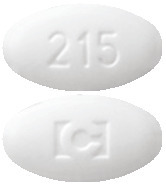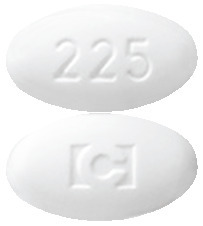What is in this leaflet
This leaflet answers some common questions about NUVIGIL tablets. As this leaflet does not contain all the available information, it is important that you talk to your doctor or pharmacist.
All medicines have risks and benefits. Your doctor has weighed the risks of you receiving NUVIGIL against the benefits this medicine is expected to have for you.
If you have any concerns about taking this medicine, ask your doctor or pharmacist.
Keep this leaflet. You may need to read it again.
What NUVIGIL is used for
NUVIGIL is used to improve wakefulness in people with excessive daytime sleepiness associated with the medical condition known as narcolepsy or with Obstructive Sleep Apnoea/Hypopnoea Syndrome (OSAHS), or shift work sleep disorder (SWSD).
In narcolepsy, there is a sudden and irresistible tendency to fall asleep during normal waking hours. This happens at unpredictable times, even when it is inappropriate or may be unsafe to do so. NUVIGIL decreases this unwanted excessive daytime sleepiness.
With OSAHS, daytime sleepiness may occur due to an interrupted night time sleep. NUVIGIL only treats the symptom of sleepiness and does not treat the cause of OSAHS. Whilst taking NUVIGIL you should continue with treatments intended to help manage your underlying medical condition, such as Continuous Positive Airway Pressure, unless your doctor tells you otherwise.
If you have been diagnosed with moderate to severe chronic Shift Work Sleep Disorder (SWSD) and non-drug therapies have been unsuitable or unsuccessful, NUVIGIL may be prescribed to keep you awake during your work shift.
Precisely how NUVIGIL works is not known, but it is known that it acts on the central nervous system (the brain). It differs from other stimulant medicines that promote wakefulness. NUVIGIL increases wakefulness.
Your doctor may have prescribed NUVIGIL for another reason. Ask your doctor if you have any questions about why NUVIGIL has been prescribed for you.
Before you take NUVIGIL
When you must not take it
You must not take NUVIGIL if you:
- are allergic to armodafinil, modafinil or any of the other ingredients listed at the end of this leaflet. (See "NUVIGIL tablets description"). Signs of allergic reaction may include a skin rash, itching, shortness of breath or swelling of the face, lips or tongue
- are pregnant currently,planning to become pregnant or likely to become pregnant or are breastfeeding.
If you could become pregnant, you should confirm by a pregnancy test that you are not pregnant within a week prior to starting treatment. Armodafinil is suspected to cause birth defects if taken during pregnancy.
Do not take NUVIGIL if the packaging shows signs of tampering or the tablets do not look quite right.
Do not take NUVIGIL if the expiry date on the packaging has passed.
If you are not sure about whether you should start taking NUVIGIL, you should contact your doctor.
Before you take it
Before you start taking NUVIGIL you should discuss with your doctor any of the following points which apply to you. If you:
- are under 18 or over 65 years old
- have a history of mental health problems
- have heart problems, including, for example, angina (chest pain), previous heart attack, enlarged heart
- have an abnormal/irregular heart rhythm
- have high blood pressure or your high blood pressure is controlled by medication
- have kidney or liver problems
- are taking hormonal contraceptives
- are pregnant, could become pregnant or are planning to become pregnant
- are currently receiving treatment for anxiety
- are breastfeeding
- are taking brain stimulants, such as methylphenidate
- are taking any medicines to treat depression, including those called monoamine oxidase inhibitors (MAOIs)
- are taking medicines to treat epilepsy or fits, such as phenytoin, oxcarbamazepine, carbamazepine and phenobarbitone
- are taking medicines to treat fungal infections, such as ketoconazole and itraconazole
- are taking medicines to help you sleep (sedatives)
- are taking antibiotics such as rifampicin or erythromycin, clarithromycin
- are taking cyclosporine, a medicine used to stop organ transplant rejection
- are taking propranolol, a medicine used to treat, for example, high blood pressure, heart problems or migraine
- are taking warfarin, a medicine used to prevent unwanted blood clotting
- are taking theophylline, a medicine used in asthma and lung problems
- are taking quetiapine, a medicine used to treat mental health conditions such as schizophrenia or bipolar disorder
- are taking omeprazole or esomeprazole, medicines used to treat stomach ulcers or gastric reflux
- are taking any other medicines, including any available without a prescription from your pharmacy, supermarket or health food shop
Tell your doctor about any of the above before you take NUVIGIL.
Your doctor will discuss the risks and benefits of using NUVIGIL.
How to take NUVIGIL
It is important that you take this medicine as directed by the doctor. Your doctor will tell you how much you should take, when and how often. Follow your doctor's instructions. If you are unsure ask your doctor or pharmacist.
How much should you take
Each NUVIGIL tablet contains 50mg, 150mg or 250mg of armodafinil.
The usual daily dose of armodafinil depends on individual response. For sleepiness associated with narcolepsy or OSAHS, the dose ranges from 150mg to 250mg.
For SWSD, a dose of 150mg is recommended.
Do not exceed the recommended daily dose unless directed to do so by your doctor.
When and how should you take the tablets
For sleepiness associated with narcolepsy or OSAHS, you should take your NUVIGIL tablet as one dose, in the morning.
For narcolepsy or OSAHS, do not take your NUVIGIL tablet later than midday, or you may have trouble sleeping at night.
For SWSD, you should take your NUVIGIL tablet as a single dose 1 hour prior to commencing your shift work.
Swallow the tablet whole with a little water.
Take your dose before food as food can slow down the rate at which the treatment enters your blood stream and may delay the effects of your medication.
If you are currently on another treatment for narcolepsy, your doctor will advise you how best to withdraw from that treatment and begin taking NUVIGIL. Other stimulants used for narcolepsy may cause a "high" feeling. Be aware therefore that you may feel different as you withdraw from other stimulants. NUVIGIL is not associated with this "high" feeling. It works on excessive daytime sleepiness.
NUVIGIL only treats the symptom of sleepiness. Other treatments intended to help manage your underlying medical condition should still be used regularly, unless your doctor tells you otherwise. You should commence or continue disease-modifying interventions (for example, Continuous Positive Airway Pressure).
REMEMBER: This medicine is only for you. Only a doctor can prescribe it for you. Never give it to anyone else. It may harm them, even if their symptoms appear to be the same as yours.
If you forget to take it
If you miss a dose of NUVIGIL tablets, just take the next dose at your usual time. Do not take an extra dose to "catch up".
While you are taking NUVIGIL
Things you must do
If you could become pregnant, you should confirm by a pregnancy test that you are not pregnant within a week prior to starting treatment.
Tell your doctor if you are planning to become pregnant.
If you become pregnant while you are taking NUVIGIL, stop taking it and tell your doctor immediately.
If you are about to be started on any new medicine, tell your doctor and pharmacist that you are taking NUVIGIL.
Tell your doctor if you believe that NUVIGIL is not helping your condition. Your doctor may need to change the dose.
Things you must not do
Do not give NUVIGIL to anyone else, even if they have the same symptoms as you.
Things to be careful of
NUVIGIL may reduce the effectiveness of hormonal contraceptives (including the contraceptive pill, implants, injectables and some intrauterine devices (IUDs)).
If you are using hormonal contraception, you should use an alternative non-hormonal method of birth control together with your current contraceptive whilst taking NUVIGIL and for 2 months after you stop treatment with NUVIGIL.
Do not drive or operate machinery until you know how NUVIGIL affects you.
Side Effects
NUVIGIL may cause you to have a serious rash.
Stop taking NUVIGIL and call your doctor right away or get emergency treatment if you have a skin rash, hives, sores in your mouth, or your skin blisters and peels, or if you have any sudden wheeziness, difficulty in breathing, swelling, or itching (especially affecting the whole body).
NUVIGIL may cause the following side effects in some people. In clinical studies, these side effects also occurred in people who received non-active (sugar) tablets. Tell your doctor if you notice any of these:
- headache
- nausea
- diarrhoea
- dry mouth
- poor appetite
- runny nose
- sore throat
- nervous feeling
- dizziness
- back pain
- feeling anxious
- upset stomach
- trouble sleeping
Tell your doctor immediately if any of the following occur:
- skin rash, hives, sores in your mouth, or your skin blisters and peels,
- swelling of your face, eyes, lips, tongue or throat,
- trouble swallowing or breathing
- fever, shortness of breath, swelling of the legs, yellowing of the skin or white of the eyes or dark urine.
- mental (psychiatric) symptoms including depression, anxiety, aggression, agitation, irritability, hallucinations, mania, thoughts of suicide or other mental problems.
- Chest pain or abnormal heart beats
- Fits or convulsions
Other side effects not listed above may also occur in some patients. Tell your doctor if you notice anything that makes you feel unwell. Do not be alarmed by this list of possible side effects. You may not experience any of them.
Overdosage
Immediately telephone your doctor or the Poisons Information Centre (telephone 13 11 26), or go to the emergency department of your nearest hospital, if you think you or anyone else may have taken too much NUVIGIL. Do this, even if there are no signs of discomfort or poisoning.
NUVIGIL tablets description
Each NUVIGIL tablet contains either 50mg, 150mg or 250mg of armodafinil.
Each tablet also contains the following inactive ingredients:
- Lactose
- pregelatinised maize starch
- microcrystalline cellulose
- croscarmellose sodium
- povidone
- magnesium stearate.
NUVIGIL 50mg tablets are white to off-white, round, uncoated tablets debossed with "C" logo on one side and "205" on the other.
NUVIGIL 150mg tablets are white to off-white, oval, uncoated tablets debossed with "C" logo on one side and "215" on the other.
NUVIGIL 250mg tablets are white to off-white, oval, uncoated tablets debossed with "C" logo on one side and "225" on the other.
NUVIGIL is supplied in packs containing 7 or 30 tablets.
Storage
Keep NUVIGIL tablets in the original packaging until it is time to take them.
Store NUVIGIL tablets below 25°C. Keep the packaging in a cool, dry place and away from direct heat and sunlight.
Do not store NUVIGIL tablets in the bathroom or near a sink.
Keep NUVIGIL tablets where children cannot reach them. A locked cupboard at least one-and-a-half metres above the ground is a good place to store medicines.
This is not all the information available on NUVIGIL. If you have any more questions or are unsure about anything, ask your doctor or pharmacist.
The Australian Registration Numbers are:
50mg tablets - bottle:
AUST R 226561
150mg tablet - bottle:
AUST R 226557
250mg tablet - bottle:
AUST R 226560
50mg tablet-blister
AUST R 272052
150 mg tablet - blister:
AUST R 226559
250 mg tablet - blister:
AUST R 226558
NUVIGIL is sponsored in Australia by:
Teva Pharma Australia Pty Ltd.
37 Epping Road
Macquarie Park
NSW 2113
This leaflet was revised in February 2020.
NUVIGIL® is a registered trademark of Teva Pharmaceutical Industries Ltd.
Published by MIMS April 2020








 The molecular formula is C15H15NO2S and the molecular weight is 273.35.
The molecular formula is C15H15NO2S and the molecular weight is 273.35.